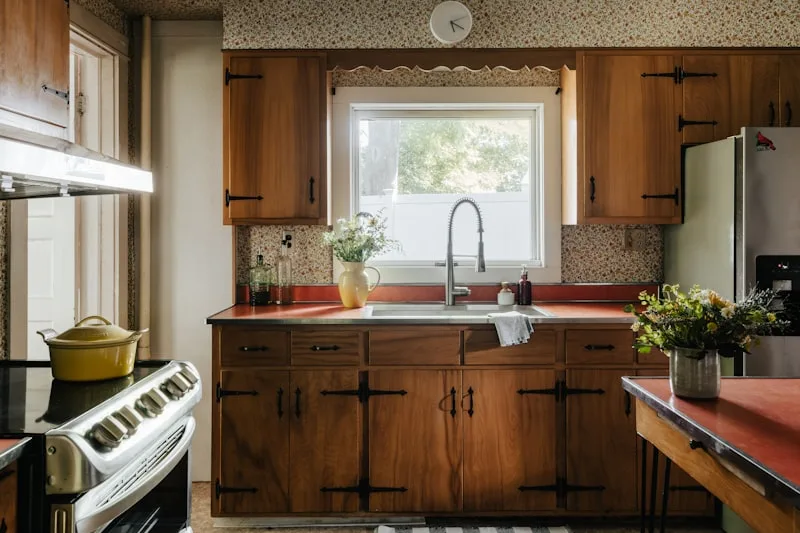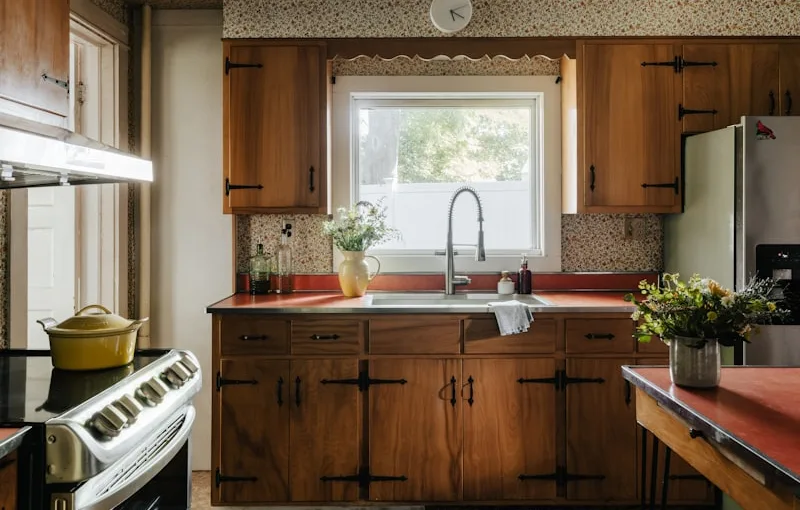Next, let’s talk about the work triangle. This is the golden rule of kitchen design, connecting your sink, stove, and refrigerator. Picture it like a dance floor where all the action happens. You want to keep these three points close enough to make your cooking flow smoothly, but not so close that you’re bumping into each other. A good rule of thumb is to keep the distance between them between 12 to 26 feet.
Now, consider the cabinet types. Do you want sleek, modern cabinets or something more rustic? Shaker-style cabinets are like the little black dress of kitchen design—timeless and versatile. And don’t forget about storage! Think about incorporating pull-out shelves or lazy Susans. They’re like secret compartments that make your kitchen feel organized and spacious.

Also, think about the height of your cabinets. If you have high ceilings, extending your cabinets all the way up can create a stunning visual effect. It’s like drawing the eye upward, making your kitchen feel grander. And let’s not overlook the color scheme. Light colors can make a small kitchen feel airy, while darker shades add a touch of drama.
Unlocking the Heart of the Home: Expert Tips for Designing Your Kitchen Cabinet Layout
First off, consider your kitchen’s workflow. Imagine you’re a chef whipping up a gourmet meal. You wouldn’t want to be running back and forth across the room, right? The classic “kitchen work triangle” is your best friend here. Position your sink, stove, and refrigerator in a triangular layout to create an efficient cooking space. It’s like having a dance floor where every step is perfectly choreographed!
Next, think about storage. We all know that clutter can kill the vibe. Opt for cabinets that reach the ceiling to maximize vertical space. It’s like adding an extra layer to your cake—more room for all those baking essentials! And don’t forget about pull-out shelves and lazy Susans. They’re the secret agents of kitchen organization, making it easy to access those hard-to-reach items.
Now, let’s talk aesthetics. Your cabinets should reflect your style, whether it’s sleek modern or cozy farmhouse. Consider mixing materials—maybe a wood finish for warmth paired with sleek metal handles for a touch of elegance. It’s like pairing your favorite jeans with a chic blazer; it just works!
Lighting is another crucial piece of the puzzle. Under-cabinet lighting can transform your kitchen into a cozy haven, perfect for late-night snacks or family gatherings. Think of it as the cherry on top of your design sundae!
From Concept to Creation: A Step-by-Step Guide to Kitchen Cabinet Layout Design
First off, start with a solid plan. Grab a tape measure and jot down the dimensions of your kitchen. Think of it as sketching the outline of your masterpiece. You wouldn’t paint a wall without knowing its size, would you? Next, consider your cooking habits. Are you a gourmet chef or a microwave magician? This will influence where you place your cabinets.
Now, let’s talk about the layout. Picture your kitchen as a stage. The cabinets are the actors, and they need to be positioned for the best performance. The classic work triangle—sink, stove, and fridge—should be your guiding star. Keep these elements close enough to make cooking a breeze, but not so close that you’re bumping into each other.
Once you’ve got the layout, it’s time to choose your cabinet style. Do you want sleek and modern, or warm and rustic? Think of it like choosing an outfit for a big event; you want something that reflects your personality.
Next, consider the materials. Solid wood, laminate, or maybe a mix? Each option has its own vibe and durability. It’s like picking the right ingredients for your dish—quality matters!
Maximize Space and Style: Innovative Kitchen Cabinet Layout Ideas for Every Home
First off, consider the open shelving trend. It’s like giving your kitchen a breath of fresh air! By swapping out some upper cabinets for open shelves, you not only create an illusion of more space but also showcase your favorite dishes and decor. It’s a bit like curating a gallery of your culinary treasures. Plus, it encourages you to keep things organized—who wants to display clutter?
Now, if you’re short on square footage, think vertical! Tall cabinets that reach the ceiling can be a game-changer. They draw the eye upward, making the room feel larger while providing ample storage for all your kitchen gadgets. It’s like stacking books on a shelf; the higher you go, the more you can fit!
Another clever idea is the corner cabinet. Instead of letting that awkward space go to waste, opt for a lazy Susan or pull-out shelves. It’s like having a secret compartment where you can hide all those pots and pans. Who doesn’t love a little surprise in their kitchen?
Lastly, don’t underestimate the power of color and texture. A bold cabinet color can serve as a statement piece, while textured finishes add depth and interest. Think of it as dressing your kitchen in a stylish outfit—every detail counts! So, whether you’re a minimalist or a maximalist, there’s a layout idea out there that can help you maximize both space and style in your kitchen.
The Art of Organization: How to Design a Functional Kitchen Cabinet Layout
First off, think about your cooking habits. Are you a baking enthusiast or a stir-fry wizard? Tailoring your cabinet layout to your cooking style is key. Place your pots and pans near the stove for easy access, and keep your baking sheets close to the oven. It’s like setting up a stage for a performance—everything should be in its right place for the best show!
Next, let’s talk about vertical space. Don’t just think horizontally; think up! Installing shelves or using stackable containers can maximize your cabinet space. It’s like playing Tetris—fitting everything in just right. You can even use clear bins to categorize items, making it easy to spot what you need without digging through a chaotic mess.
And what about those pesky spices? Instead of cramming them into a dark corner, consider a pull-out spice rack. It’s like having a personal assistant that brings your favorite flavors right to you. Plus, labeling your jars can save you time and prevent those “What’s this?” moments when you’re in the middle of a recipe.
Frequently Asked Questions
What materials are best for kitchen cabinets in my layout?
Choosing the right materials for kitchen cabinets depends on durability, aesthetics, and maintenance. Solid wood offers a classic look and longevity, while plywood is a sturdy and cost-effective alternative. For a modern touch, consider laminate or MDF, which are easy to clean and available in various finishes. Evaluate your kitchen layout and lifestyle to select materials that balance style and functionality.
How can I maximize storage in my kitchen cabinet design?
To maximize storage in kitchen cabinet design, consider using vertical space by installing taller cabinets, incorporating pull-out shelves and organizers, and utilizing corner cabinets with lazy Susans. Opt for multi-functional furniture, such as islands with storage, and keep frequently used items accessible while storing less-used items higher or further back. Additionally, use clear containers for visibility and consider adjustable shelving to accommodate various item sizes.
How do I measure my kitchen space for cabinet design?
To measure your kitchen space for cabinet design, start by clearing the area of any obstacles. Use a tape measure to record the length and width of the walls where cabinets will be installed. Measure the height from the floor to the ceiling, and note any windows, doors, or appliances that may affect cabinet placement. Be sure to take measurements at multiple points to account for any irregularities in the walls. Document all measurements clearly for accurate cabinet design.
What are the key factors to consider when designing a kitchen cabinet layout?
When designing a kitchen cabinet layout, consider the available space, the work triangle (the relationship between the sink, stove, and refrigerator), storage needs, cabinet styles and materials, accessibility, and the overall flow of the kitchen. Prioritize functionality and aesthetics to create an efficient and visually appealing kitchen.
What styles of kitchen cabinet layouts are available?
Various kitchen cabinet layouts are available to optimize space and functionality. Common styles include L-shaped, U-shaped, galley, and island layouts. Each design caters to different kitchen sizes and workflows, allowing for efficient storage and accessibility. Consider your kitchen’s dimensions and your cooking habits when choosing the best layout.
